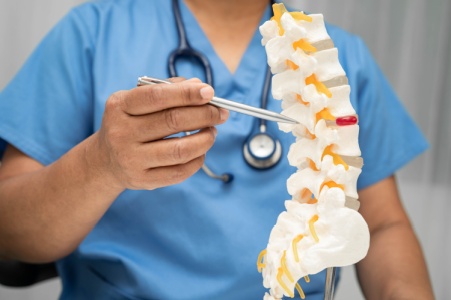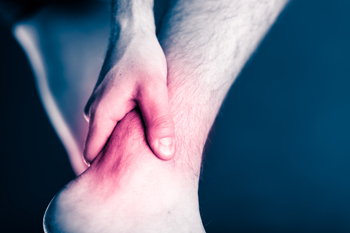Blog
Items filtered by date: September 2025
Possible Causes of Mid-Back Pain

Mid-back pain often comes from issues in the thoracic spine, such as misaligned vertebrae, compressed joints, irritated nerves, or strained muscles and ligaments. Poor posture, repetitive bending or lifting, trauma, or undue stress can place uneven forces on the mid-back. This can cause stiffness, sharp or dull aches between the shoulder blades, reduced mobility, and even pain that radiates toward the ribs or shoulders. A chiropractor can perform a detailed evaluation of the thoracic spine, ribs, and related structures to identify where alignment is off or where joints are restricted. Through precise spinal adjustments and skilled manipulation of affected segments, a chiropractor works to restore normal joint positioning, relieve pressure on spinal nerves, improve movement, and ease muscle tightness. By improving alignment and joint motion in the mid-back, treatment helps the body heal more efficiently and reduce discomfort. If you are suffering from mid-back pain, it is suggested that you make an appointment with a chiropractor for an exam and treatment options.
Mid back pain, centered in the thoracic region, refers to discomfort or stiffness in the upper and middle back, which connects to the ribcage. This area is essential for stability and movement, but poor posture, repetitive strain, or injuries can cause irritation and tension. Pain may range from a dull ache to sharp, localized discomfort that worsens with certain movements or prolonged sitting.
Chiropractors take a thorough approach to managing mid back pain, identifying misalignments or tension in the thoracic spine that may contribute to discomfort. Spinal adjustments, tailored to improve alignment and relieve pressure, form the core of treatment. Supporting therapies like guided exercises, posture correction techniques, and ergonomic recommendations are also employed to enhance recovery and prevent future issues. Chiropractic care helps restore balance and function, allowing patients to move freely and live without pain.
1. Can carrying a heavy bag or backpack cause mid back pain?
Yes, uneven weight distribution from a heavy bag can strain the thoracic spine and surrounding muscles, leading to pain. Chiropractors can help correct alignment and recommend strategies to reduce strain.
2. How can chiropractic care help desk workers with mid back pain?
Chiropractors address postural imbalances and spinal restrictions caused by prolonged sitting, using adjustments and ergonomic advice to relieve pain and prevent recurrence.
For additional information, please contact our office located in Orinda, CA .
What Is Degenerative Disc Disease?

Degenerative disc disease is the gradual breakdown of spinal discs that can lead to pain, stiffness, and reduced mobility, progressing through four stages. In the dysfunction stage, discs begin to lose flexibility, causing mild discomfort. The dehydration stage involves loss of fluid within the disc, leading to stiffness and increased pain. During stabilization, the body forms bone spurs and scar tissue, sometimes reducing mobility. In the collapsing stage, discs deteriorate further, potentially causing chronic pain and nerve compression. Risk factors include aging, poor posture, repetitive strain, and prior spinal injuries. A chiropractor can help by improving alignment, reducing pressure on nerves, and providing exercises to support spinal health. If you have this disease, it is strongly suggested that you consult a chiropractor for expert guidance and natural care.
Degenerative Disc Disease
Degenerative disc disease, or DDD, is a condition characterized by the gradual wear and tear of the spinal discs, which act as cushions between vertebrae. As these discs deteriorate, they lose height, elasticity, and hydration, resulting in reduced shock absorption and increased friction between bones. This degeneration can lead to chronic pain, stiffness, and decreased mobility, often radiating to other areas of the body due to nerve irritation.
Management of Degenerative Disc Disease
Chiropractors manage degenerative disc disease by reducing stress on the spine and enhancing mobility to alleviate discomfort. They use targeted spinal adjustments to help improve alignment, which minimizes nerve compression and promotes better disc health. By restoring spinal balance, chiropractic care can help reduce pain and prevent further degeneration.
Complementary treatments like stretching exercises, strengthening routines, and postural training often accompany chiropractic adjustments to provide a comprehensive approach to managing DDD. These additional therapies aim to enhance flexibility, reinforce supporting muscles, and protect the spine from further strain.
Chiropractic care focuses on a non-invasive, holistic approach, offering relief without reliance on medication or surgery. By addressing the underlying mechanics of the spine, chiropractors work to help patients manage DDD symptoms effectively and enjoy improved quality of life over time.
1. How often should someone with degenerative disc disease see a chiropractor?
The frequency of visits varies based on individual needs, but patients often benefit from regular treatments initially, which can then be adjusted as symptoms improve or stabilize.
2. Will chiropractic care stop the progression of degenerative disc disease?
While chiropractic care cannot reverse the condition, it can help alleviate symptoms, reduce pain, and improve quality of life, making it easier to stay active, which may slow progression over time.
3. How does a chiropractor evaluate the progression of degenerative disc disease over time, and can they adjust their techniques as the condition evolves?
Chiropractors typically monitor changes in mobility, pain levels, and overall function, adjusting their treatment plans to accommodate increased sensitivity or stiffness as the disease progresses.
4. Does chiropractic care provide long-term relief for degenerative disc disease?
While chiropractic care may not cure degenerative disc disease, regular treatment can offer long-term relief by managing pain, reducing inflammation, and improving joint mobility, which can enhance quality of life over time.
If you have any questions please feel free to contact our office located in Orinda, CA .
Ease Joint Stiffness and Pain

If your joints often feel stiff, achy, or less flexible, it may be linked to joint dysfunction, surrounding muscle tension, or inflammation. These problems can limit your range of motion, but gentle adjustments may help improve joint mobility, reduce strain, and ease pressure on affected areas.
For relief from joint stiffness, book an appointment today.
Understanding Ankle Pain and Chiropractic Care

Ankle pain refers to discomfort in the ankle joint, which is a complex structure of bones, ligaments, tendons, and muscles that support movement and stability. Causes include injuries, overuse, poor footwear, or underlying conditions. Common issues are Achilles tendonitis, which affects the tendon at the back of the ankle, posterior tibial tendonitis that impacts arch support, and bursitis, which is inflammation of fluid-filled sacs around the joint. These problems can lead to swelling, stiffness, and difficulty walking. A chiropractor can help by improving alignment, reducing inflammation, and supporting healing through adjustments and personalized care. Ankle pain can often affect daily activities. If you have developed ankle pain for any reason, it is suggested that you contact a chiropractor who can provide natural and effective care.
Ankle pain is a common problem that can significantly disrupt daily life, often stemming from injuries, overuse, or underlying conditions like arthritis. Sprains, where ligaments are overstretched or torn, are among the most frequent causes, leading to swelling, stiffness, and difficulty bearing weight. Overuse injuries such as tendonitis, caused by repetitive strain, can create persistent discomfort, while misalignment in the joint or biomechanical imbalances in the foot or leg may contribute to chronic pain.
If left untreated, these issues can lead to improper healing, reduced mobility, and a higher risk of re-injury.
Addressing the underlying cause is critical for restoring function and preventing long-term complications. Chiropractic care offers a natural approach to managing ankle pain, focusing on improving alignment, mobility, and overall function while supporting recovery through targeted therapies and exercises.
1. Will chiropractic treatment for ankle pain hurt?
Chiropractic treatments are designed to be gentle and tailored to each patient's comfort level. Adjustments and therapies are performed carefully to avoid causing pain, even in sensitive or swollen areas. Most patients report feeling relief and improved mobility after treatment, although some individuals may experience mild soreness, similar to the feeling after a workout, as the body adjusts.
2. How long does it take to see results from chiropractic care for ankle pain?
The timeline for improvement varies depending on the severity and cause of the pain. Some patients experience relief after just a few sessions, while chronic or complex cases may take longer to resolve.
If you have any questions, please feel free to contact our office located in Orinda, CA .
Chiropractic Relief for Subacromial Shoulder and Arm Pain

Subacromial shoulder and arm pain occurs when the tissues around the shoulder joint, including tendons and bursae, become irritated or compressed. Common causes include repetitive overhead movements, poor posture, injuries, or inflammation from conditions like bursitis or tendonitis. Symptoms often involve pain with movement, stiffness, weakness, or a limited range of motion in the shoulder or arm. Risk factors include aging, participation in sports, heavy lifting, and previous shoulder injuries. A chiropractor can help by restoring proper joint alignment, improving shoulder mechanics, reducing inflammation, and supporting natural healing. If you are experiencing persistent shoulder or arm pain, it is suggested that you visit a chiropractor who can provide targeted care to restore function and reduce discomfort.
Shoulder and arm pain can significantly affect daily life, making simple tasks challenging. This pain often arises from issues such as rotator cuff injuries, tendonitis, nerve compression, or even misalignments in the spine or shoulders. Symptoms can range from a dull ache and stiffness to sharp, shooting pain that radiates down the arm, limiting mobility and impacting overall comfort.
Chiropractic care offers a non-invasive approach to managing shoulder and arm pain by focusing on the musculoskeletal system. Chiropractors assess the shoulder, neck, and spine alignment to identify potential sources of nerve compression or joint dysfunction. Gentle adjustments aim to restore proper alignment in the affected areas, which can relieve nerve pressure, reduce inflammation, and encourage natural healing.
In addition to adjustments, chiropractors may recommend exercises to strengthen the surrounding muscles and improve flexibility. Stretching routines can help relieve tension, while strengthening exercises provide better support to the shoulder and arm, preventing further strain.
By addressing the root causes of discomfort, chiropractic care provides a holistic approach to managing shoulder and arm pain. This method promotes long-term relief by restoring alignment, enhancing function, and encouraging a more active, pain-free lifestyle without relying on medication or surgery.
1. How does chiropractic care help with frozen shoulder?
Chiropractors use gentle mobilization and targeted adjustments to improve joint flexibility. Soft tissue therapies can also reduce inflammation and improve function.
2. Is shoulder pain always caused by a shoulder issue?
No, shoulder pain can originate from the neck or upper back due to nerve compression or referred pain. Chiropractors assess the entire musculoskeletal system to find the root cause.
3. Are chiropractic adjustments safe for shoulder pain caused by arthritis?
Yes, chiropractors use gentle, non-invasive techniques tailored to reduce arthritis-related pain and improve joint mobility.
If you have any questions please feel free to contact our office located in Orinda, CA .
Tennis Elbow and Chiropractic Relief

Tennis elbow is a condition where the outer part of the elbow becomes painful and tender due to overuse of forearm muscles and tendons. It can be caused by activities, such as playing tennis, rowing, using a screwdriver, hammering, or performing repetitive plumbing work. Symptoms include pain radiating from the elbow to the forearm, weakness in grip, and discomfort when lifting or twisting objects. A chiropractor can help by assessing joint and muscle function, providing gentle adjustments, soft tissue therapy, and exercises to reduce strain and improve mobility. If tennis elbow is affecting your daily activities, it is suggested that you seek chiropractic care to relieve pain, restore function, and prevent future injury.
Tennis and Golfer's Elbow
Tennis and golfer's elbow, or medial epicondylitis, is a condition caused by inflammation or irritation of the tendons on the inner side of the elbow. Despite its name, this condition is not limited to golfers and tennis players. It can affect anyone engaging in repetitive wrist or forearm motions, such as throwing, lifting, or typing. Symptoms include pain, tenderness, and stiffness on the inner elbow, sometimes extending into the forearm. Weak grip strength and difficulty with everyday tasks are common complaints.
Chiropractic care can play a role in managing golfer's elbow by addressing muscle tension and improving joint function. Gentle adjustments may reduce strain on the affected area, while soft tissue therapies and stretching techniques can help alleviate discomfort and promote healing. Chiropractors may also provide advice on modifying activities to reduce stress on the tendons, offering a holistic approach to recovery and prevention.
1. Can tennis or golfer’s elbow occur without playing sports?
Yes, these conditions are often caused by repetitive motions like typing, lifting, or using tools. Chiropractors can assess and treat the root causes of these repetitive strain injuries.
2. Should I avoid chiropractic care during the acute phase of tennis or golfer's elbow?
Gentle adjustments and soft tissue techniques can still be beneficial, reducing inflammation and improving mobility without aggravating the injury.
For additional information, please contact our office located in Orinda, CA .
